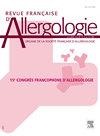Rhinite allergique de l’enfant : étude clinique et évaluation de la qualité de vie avant et après traitement selon l’âge
IF 0.3
4区 医学
引用次数: 0
Abstract
Aim
This study aims to investigate the characteristics of allergic rhinitis in children and evaluate the impact of treatment on their quality of life, stratified by age.
Methods
A prospective descriptive study was conducted on children aged 4 to 16 years who were diagnosed with allergic rhinitis for the first time at the beginning of the study. The study population was divided into two age groups: group 1 (4–12 years) and group 2 (12–16 years). The quality of life before and after 6 months of treatment was assessed using the Juniper Allergic Rhinoconjunctivitis Quality of Life Test (RQLQ) and the ARIA classification as endpoints.
Results
The study included 100 patients, 58 of whom were male, with a mean age of 9 ± 3.3 years. Prior to treatment, 79 children had an overall score of 4 or higher, indicating they were “rather to extremely annoyed”. Children in group 1 reported nasal discomfort as their main complaint, with a score of 5.05 indicating they were “very annoyed”. Children in group 2 reported emotional impact as their main complaint, with a mean score of 4.54 indicating they were “rather to very annoyed”. Children with asthma had a higher RQLQ score than those without (P < 0.0001). Following six months of treatment, we observed a statistically significant improvement in ARIA classification and quality of life scores. The overall RQLQ score decreased from 3.82 to 1.79 for group 1 and from 3.74 to 1.73 for group 2. Logistic regression revealed that poor compliance and persistent allergen exposure were the main factors contributing to poor therapeutic control (odds ratio of 57 and 46, respectively).
Conclusion
This conclusion is based on objective evidence and avoids biased language. To improve management, it is recommended that quality of life tests for children treated for allergic rhinitis to be generalized. The field still lacks proper codification. No changes were made to the original content.
儿童过敏性鼻炎:临床研究和根据年龄评估治疗前后的生活质量
方法 对研究开始时首次被诊断患有过敏性鼻炎的 4-16 岁儿童进行前瞻性描述性研究。研究对象分为两个年龄组:第一组(4-12 岁)和第二组(12-16 岁)。以瞻博过敏性鼻结膜炎生活质量测试(RQLQ)和ARIA分类作为终点,评估治疗前后6个月的生活质量。治疗前,79 名儿童的总分达到或超过 4 分,表明他们 "相当烦恼到非常烦恼"。第 1 组儿童的主要主诉是鼻部不适,5.05 分表示他们 "非常烦恼"。第 2 组儿童的主要主诉是情绪影响,平均得分为 4.54 分,表明他们 "相当恼火到非常恼火"。哮喘患儿的 RQLQ 得分高于非哮喘患儿(P < 0.0001)。经过 6 个月的治疗,我们观察到 ARIA 分级和生活质量评分有了统计学意义上的显著改善。第一组的 RQLQ 总分从 3.82 降至 1.79,第二组从 3.74 降至 1.73。逻辑回归显示,依从性差和持续接触过敏原是导致治疗控制不佳的主要因素(几率比分别为 57 和 46)。为改善管理,建议对接受过敏性鼻炎治疗的儿童进行生活质量测试。该领域仍缺乏适当的编纂。未对原文内容做任何改动。
本文章由计算机程序翻译,如有差异,请以英文原文为准。
求助全文
约1分钟内获得全文
求助全文
来源期刊

Revue Francaise d Allergologie
Medicine-Immunology and Allergy
自引率
33.30%
发文量
349
期刊介绍:
La Revue Française d''Allergologie : un véritable forum pour faire connaître des travaux originaux et permettre la diffusion de l''information auprès de toutes les spécialités concernées par les pathologies allergiques. La Revue Française d''Allergologie (8 numéros par an) est au carrefour de nombreuses spécialités - dermatologie, pédiatrie, ORL, pneumologie, ophtalmologie, médecine interne - qui, toutes, ont à traiter des maladies allergiques. Les symptômes des allergies fondés sur des mécanismes communs sont le plus souvent associés et se succèdent chez un même patient. En forte progression depuis 20 ans, les maladies allergiques sont dans l''attente de perfectionnements et d''avancées thérapeutiques qui permettront aux nombreux patients qui en sont atteints de mieux vivre avec leurs allergies. La Revue Française d''Allergologie se veut donc un véritable forum de discussions et d''échanges entre tous les spécialistes confrontés aux pathologies
 求助内容:
求助内容: 应助结果提醒方式:
应助结果提醒方式:


